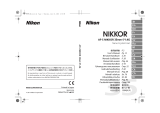
16
Jp
En
De
Fr
Es
Se
Ru
Nl
It
Cz
Sk
Ck
Ch
Kr
Usable cameras and available
functions
There may be some restrictions or limitation for available
functions. Refer to camera’s User’s Manual for details.
Cameras
Function
Exposure mode
VR AF
P
*1
6$0
Nikon digital SLR (Nikon FX/DX format)
cameras, F6, F5, F100, F80-Series/
N80-Series*, F75-Series/N75-Series*,
F65-Series/N65-Series*
Pronea 600i/6i*, Pronea S*
2
—
F4-Series, F90X/N90s*, F90-Series/N90*,
F70-Series/N70*
—
——
F60-Series/N60*, F55-Series/N55-Series*,
F50-Series/N50*, F-401x/N5005*,
F-401s/N4004s*, F-401/N4004*
——
F-801s/N8008s*, F-801/N8008*,
F-601
M/N6000*
——
——
F3AF, F-601/N6006*, F-501/N2020**,
Nikon MF cameras (except F-601
M/N6000*)
— — ————
: Possible
—
: Not possible
VR: Vibration reduction AF: Autofocus
*: Sold exclusively in the USA
**: Sold exclusively in the USA and Canada
*1: P includes AUTO and Vari-Program System.
*2: Manual (M) is not available.
Thank you for purchasing the AF-S NIKKOR 16-35mm f/4G ED VR lens. Before using this lens,
please read these instructions and refer to your camera's User's Manual.
Major features
•
The Nano Crystal Coat deposited on some of the
lens elements ensures that fine, clear images can be
reproduced under various shooting conditions, from
the sunny outdoors to spotlighted interior scenes.
•
By enabling vibration reduction (
VR
), slower
shutter speeds (approximately four stops*) can be
used, thus increasing the range of usable shutter
speeds and zoom positions, particularly when hand-
holding the camera. (*Based on results achieved
under Nikon measurement conditions. The effects of
vibration reduction may vary according to shooting
conditions and use.)
•
Superior optical performance and rendering
characteristics are maximized with the use of three
aspherical lens elements and two extra-low
dispersion (ED) glass elements, which ensure
correction of chromatic aberration. In addition, the
rounded aperture produces soft and pleasing blur
characteristics in portions of pictures that are out-of-
focus.
Important
•
When mounted on Nikon DX format digital SLR
cameras, such as the D300-Series and D90, the lens’
picture angle becomes 83°-44° and its 35mm
equivalent focal length is approx. 24-52.5 mm.












